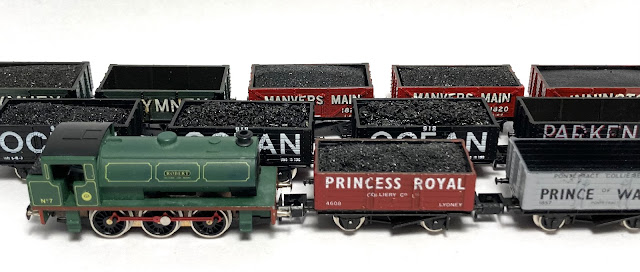When I began my N scale adventure I had to over come the mental baggage of ‘toy like’ models with bright large flanges, poorly detailed and caricatured models…
Through the exploration of what is possible in the scale I’ve been able to breathe ‘larger scale’ thinking into a small space, and with those eyes can see past the past, so to speak, as to the possibilities of modern British N. My good friend Chris however, the original instigator with ‘why not’ has a life long love of the scale. Whilst his kind words of encouragement have marvelled at the way modern N transcends scale in a way it’s parents could never imagine he walks the tight rope between models of his childhood and the possibilities of today.
 |
| Models from my late Grandpa’s collection, a mix of RTR Farish, RTR Peco and kit built Peco. Photo James Hilton. |
This was N, yet it’s N as I know it in terms I immediately recognize like hearing you native language in a country you’ve always wanted to live in that was perfect, excepting they don’t speak it. This era of models feels like a wonderful summary of my experiences with British N: always a tease.
Dressed in a cozy blanket of nostalgia and breathing in the familiar sights of the models invites thoughts like: these models are so far away from the median work in 2mm finescale, so very far apart, that it was hard to imagine what today’s British N scale model is.
Even that kind of criticism is something that comes to mind with no foul tempering. I love the scale of these models. Everything about N scale makes my heart rush and beckons my attention. Something about N, and those models that harbour around that scale, just works.
I think this is why the work you’re doing in British N is so powerful for me: it feels like the dream realised in ways I couldn’t imagine; like time travel almost in the way that it answers a prayer a teenage me wished upon.

On a mechanistic level, taking a model from my Grandpa’s collection and comparing to a model 20 years or so it’s junior we still notice Graham Farish enjoy heavy plank gaps but the finer wheels and darker tyres are the most pleasing upgrade. Out of the box they’re still lumbered with ugly massive couplings and although the brake gear is commendably fine it’s the wheels that make the biggest difference, especially on the steam locomotives in the range. We’re now treated to a prototype fidelity OO enjoys, but go back 20 years in the senior scale Hornby were shoving Big Four markings on generic or inappropriate models, so we can’t really hold that against our Farish NE pattern van wearing LMS markings.
 |
| Compared new(ish) Farish left, to Farish (Poole era) right. Photo James Hilton |
However, on an emotional level, todays British N feels pretty much right (the track is a touch under gauge, 1/148 models on approximately 1/160 track gauge, but it’s ‘righter’ than OO). The models, especially examples like the Farish Class 31 and Dapol 26/33 are superb renditions of the prototype that really capture the bulk of these machines in this tiny scale. My enjoyment has come from showing that N isn’t all big layouts and long trains, and that small cameo layouts are possible, and even more than that, an enjoyable challenge for your modelling skills.
If you’ve enjoyed this double act, why not take a look at some of the other co-created Trans-Atlantic material Chris and I have produced over the years using the Hilton and Mears label. In the meantime, until next time, more soon…



My early experiences with N were just over 40 years ago; a Farish 08 (same chassis as your Grandpa's Austerity) and a clutch of wagons, mostly the GF version of a 16 Tonner, bought from either Beatties in Brighton or Taylor & McKenna in Bletchley. I remember repainting the various liveried wagons into BR bauxite with wobbly white diagonal stripes as all those I'd seen in reality were fitted...no unfitted trains on thr SR by then. Unfortunately I went with the Farish track and points which weren't great. I don't think I got as far as a layout and the 08 chassis later became a donor for a 009 loco; no idea what happened to the wagons! Happy memories though...
ReplyDeleteI got back into N around 20 years ago and have lurched along with it sporadically since. It was just after the Bachmann GF takeover and the launch of the Dapol 73. I think the wheels are probably the biggest change for the better; certainly the 37 and 47 i had looked much improved. I actually bought an old Poole era VBA in bauxite a couple of weeks ago, swapped the silver wheels for some new ones and weathered it and I reckon it now stands up with a lot of the newer stuff...it'll be even better with DG couplings.
I've recently bought a Dapol 33/1 and a Graham Farish 60; both are little beauties...it looks like my late 1980s/early 1990s project has got legs (well, wheels anyway!).
There won't be a layout until we've moved but I am building up a little diorama to photograph stuff on.
Thanks for the inspiration....
Simon always lovely to hear from you, was thinking of you as I passed St Leonard’s depot earlier today… I’m pleased it’s giving you inspiration, this modern N is well worth it. It’s a shame we’ve not had a push in realism from the modelling public in general but it’s giving me lots to talk about which is good. Will you be coming to the NEC? If not I’m
Deletesure our paths will cross again sooner or later…